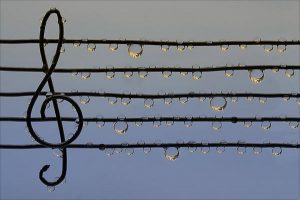Music secrets
 I think no one will argue with me if I say that music is an art form. What is art? This is a reflection of reality, real life, special, imaginative means. One can argue that there are many definitions of art, but all of them in one way or another run into what is meant by real life. In any case, any kind of art has, like any science, its subject and method. The subject is the reality that art tries to express and cognize, and the method is the specific images that this art form uses. Moreover, as we note below, the method (image) is not arbitrary, it is a function of the object and somehow corresponds to it (the object).
I think no one will argue with me if I say that music is an art form. What is art? This is a reflection of reality, real life, special, imaginative means. One can argue that there are many definitions of art, but all of them in one way or another run into what is meant by real life. In any case, any kind of art has, like any science, its subject and method. The subject is the reality that art tries to express and cognize, and the method is the specific images that this art form uses. Moreover, as we note below, the method (image) is not arbitrary, it is a function of the object and somehow corresponds to it (the object).
Another retreat. All that a person knows, all the information of this world comes to us through the senses – through sight, hearing, smell, taste, bodily sensations. Other ways to open the world simply do not exist. I hear already quiet, in some places rolling in sharp cries grumble:
– But what about intuition !?
– But what about insight !?
– And what will you do with the “direct” knowledge of the world !?
Immediately, in mid-sentence, I interrupt the cries of the protesters. Even I will not deny them right. I will just say that anyway, when the insight happened, we somehow learn about it. And we still know nothing other than through the senses – that is, either we hear words and sounds in our head, or we see a picture, or we feel something directly with the body, for example, a stupor in anticipation of a disaster that happened during times of disaster need to.
These images (real and fantastic) that generate our senses, can then be classified, summarized and put on clothes of values in a complex way, giving us an immediate assessment whether it is good for us or bad, calling for action – achievement or avoidance. So in a simplified form, the cognitive (perceiving) system of a person works. It should be noted that the “like-dislike” emotion also lives in the form of an image that is physical in nature and localized in different people in different parts of the body.
So, we somehow perceive works of art through the senses, but unlike the real world with its fullness, works of art reduce the world, impoverish and we usually have enough for their perception of only a limited number of sense organs. Moreover, these senses are specific to the subject and method of a particular type of art.
Let us try to decompose the forms of art through the prism and modalities of perception, too.
The simplest to analyze is visual art. The subject of it is the spatial relationship of objects of the world. The method, the image – the picture. Naturally, the picture is not the world, but it contains some of its invariants. The modality through which we perceive painting, graphics and sculpture (architecture and others like it) is vision. Visual perception is not a one-dimensional process, various stages of generalization of visual information occur at its different stages, and therefore certain processes in real perception correspond to even the strangest objects of painting. So, blurry pictures of impressionists or strange conglomerations of Cubist planes or the presence of faces in one Picasso picture at the same time in profile and full face is not alien to our consciousness; any visual image undergoes such transformations in the analysis. Thus, the method of art corresponds to its subject and is completely relevant to one perception modality, namely, visual. In general, everything is clear – visual art – about what we see and, most importantly, how we see it.
If we talk about dance, here we have one type of nonverbal (nonverbal) communication between people, the method (way) is the human body itself, and the modality used for perception is kinesthetic (indirectly through the visual). That is, I saw – I felt. In particular, dance by artistic means conveys one of the most, if not important, then, in any case, emotionally saturated elements of human nonverbal communication – sexual communication. It is the body, its postures, the movement, without any participation of awareness, that information is transmitted between a man and a woman – about what one of them feels towards the other, about how well they (bodies) will be together, how they are needed by each other, or, on the contrary, it is the body that will more intelligibly say “I don’t want you, go.” And this language is much stronger and more convincing than the language of words. Not for nothing, by the way, dance is mostly a pair event and its participants are a man and a woman. Anyway.
Literature. Often, even art is not considered. The most “advanced” way of knowing. Method (image) – the word. Since the word is not quite a way, it is more a symbol, a sign, a carrier of images, then literature itself reveals the widest layer of reality. The main thing is a dialogue, a monologue, an inner speech, that is, communication is external and internalized (turned inward). In the process of perception of literary works are cyclically involved.



